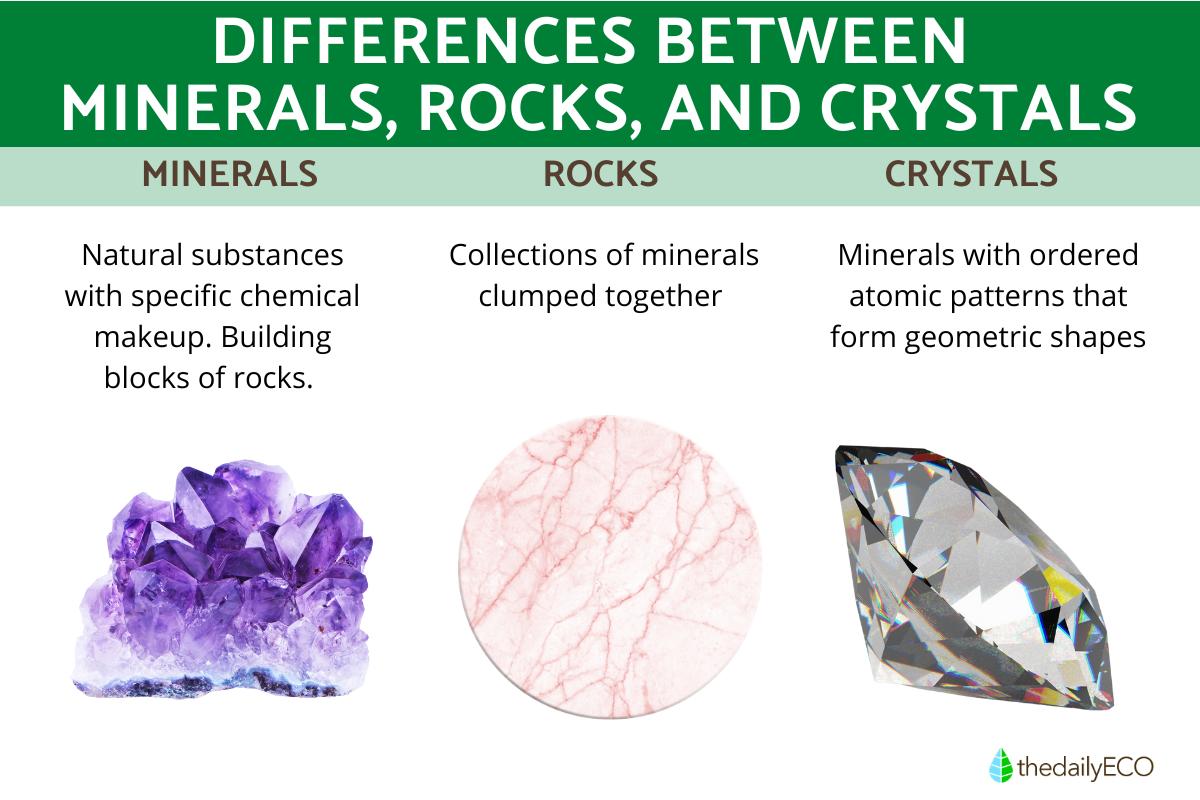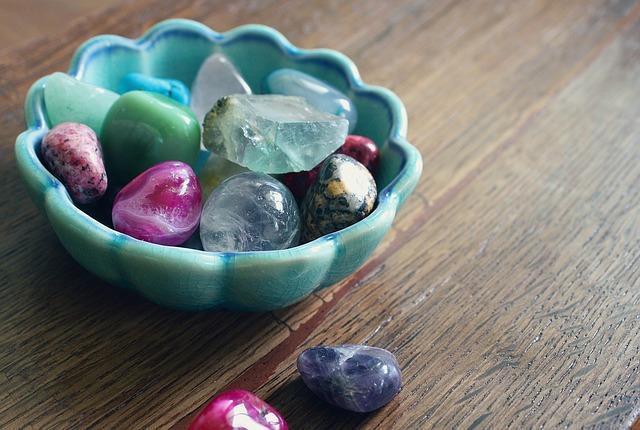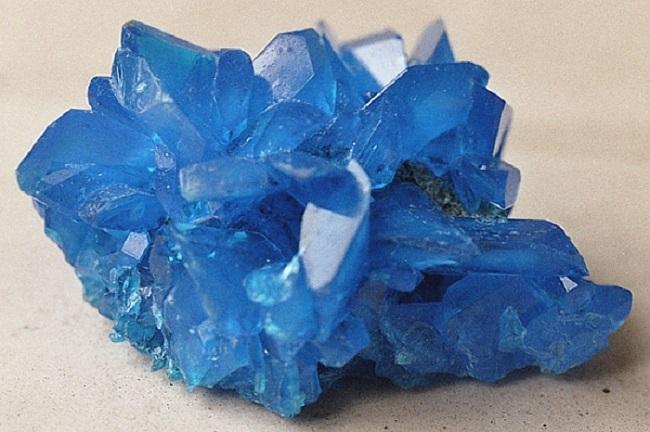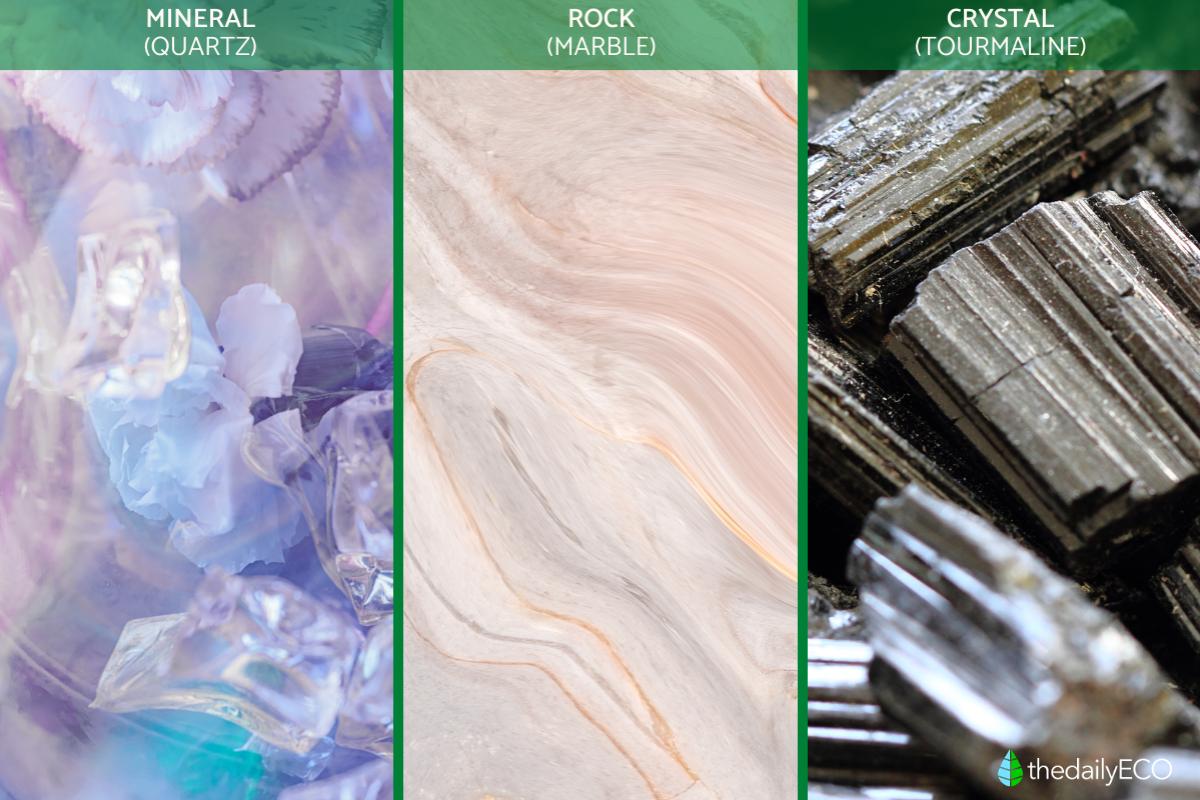What Is the Difference Between Minerals, Rocks, and Crystals?


When exploring the fascinating world of geology, the terms minerals, rocks, and crystals are often confused, even though they represent distinct and essential components of Earth's structure. These natural materials play a crucial role in shaping the planet’s surface and contribute to its overall composition. However, despite their close relationship, they differ significantly in terms of composition, formation, and structure.
The following article by thedailyECO explores what the difference between minerals, rocks, and crystals is.
What are minerals?
A mineral is a naturally occurring, inorganic solid with a specific chemical composition and a structured atomic arrangement. To be classified as a mineral, a substance must form naturally through geological processes, be inorganic (with rare exceptions like calcite in shells), and exist as a solid with a stable shape and volume under normal conditions. Each mineral has a unique chemical formula, though slight variations may occur, and its atoms are arranged in a consistent, repeating pattern.
How do minerals form?
Minerals develop through different geological processes.
- Crystallization from magma occurs when molten rock cools, allowing minerals to form based on their chemical composition and temperature.
- Some minerals precipitate from solutions, as dissolved substances solidify when conditions change, such as salt crystallizing from evaporated seawater.
- Others form through metamorphic reactions, where heat and pressure within Earth's crust alter existing minerals into new forms. These processes directly influence a mineral’s physical properties and overall appearance.
Each mineral has distinct physical properties that help in identification.
- Hardness measures resistance to scratching and reflects the strength of atomic bonds. For example, diamond ranks as the hardest natural material, while talc is soft and easily scratched.
- Cleavage describes how a mineral breaks along specific planes where atomic bonds are weaker, forming smooth surfaces, while fracture occurs when a mineral breaks irregularly.
- Luster, or how a mineral reflects light, can range from metallic and glassy to pearly or silky.
Finally, while a mineral’s color may vary due to impurities, its streak (which is the color in powdered form) is often more consistent. Hematite, for example, may appear silver or black but always leaves a red-brown streak, making it a reliable identification test.
Examples of minerals and their uses:
Many everyday materials rely on minerals, examples include:
- Quartz: is one of the most abundant minerals on Earth, is essential for glassmaking and electronics.
- Feldspar: is the most common mineral group in the Earth's crust, is used in ceramics and glass.
- Mica: known for its ability to split into thin, flexible sheets, is found in electronics and cosmetics.
- Calcite: is the main mineral in limestone and marble, plays a crucial role in construction and manufacturing.
It is important to note that different combinations of minerals create various rock types, shaping the Earth's surface and influencing everything from landscapes to industrial materials.
Ever wondered why soil appears in different colors and textures as you dig deeper? Unearth the secrets of Earth's skin in our companion article about soil's vertical architecture.

What are rocks?
A rock is an aggregate of one or more minerals formed through geological processes. Unlike minerals, rocks don't have a specific chemical composition or crystalline structure. They can contain varying proportions of different minerals, glass, organic matter, or even fossils.
Rocks form the Earth's crust and mantle and constitute the primary geological material on which we live. Their formation processes are directly linked to the Earth's dynamic systems of plate tectonics, erosion, and deposition.
Geologists classify rocks into three main types based on how they form: igneous, sedimentary, and metamorphic. Each type plays a crucial role in Earth's geological processes.
Igneous rocks:
Igneous rocks form when molten rock cools and solidifies. The cooling speed affects the size of the crystals that develop:
- Intrusive rocks (Plutonic): formed underground from slowly cooled magma, resulting in larger crystals. Examples include granite, diorite, gabbro.
- Extrusive rocks (Volcanic): formed from rapidly cooled lava at the surface, producing smaller crystals or even glassy textures. Examples include basalt, andesite, obsidian.
Sedimentary rocks:
These rocks form when layers of sediments are compacted and cemented over time. They are grouped into three categories:
- Clastic: are made from broken rock fragments. Examples include sandstone, shale, conglomerate.
- Chemical: are formed from minerals that precipitate from water. Examples include limestone, halite, gypsum.
- Organic: are derived from plant or animal remains. Examples include coal and some limestones.
Sedimentary rocks often reveal Earth's history, preserving fossils and showing past environments. Their formation also highlights how minerals contribute to rock development.
Metamorphic rocks:
Metamorphic rocks are created when existing rocks undergo intense heat, pressure, or chemical changes deep within the Earth. This process alters their mineral structure, often making them stronger and more durable.
- Foliated rocks: is when minerals align in layers due to pressure. Examples include slate, schist, gneiss.
- Non-foliated rocks: where there is no visible layering. Examples include marble, quartzite, hornfels.
During metamorphism, minerals can recrystallize into new structures, further demonstrating the deep connection between minerals, crystals, and rock formation.
Examples of rocks and their uses:
Each type of rock has unique properties that make it valuable for various applications:
- Granite: used for countertops, buildings, and monuments due to its durability and aesthetic appeal.
- Basalt: commonly used in road construction, railroad ballast, and as an aggregate in concrete due to its strength.
- Limestone: a key material in cement production, construction, and as a neutralizer in agriculture.
- Sandstone: often used for building facades, paving, and decorative stone due to its weather-resistant properties.
Ever wondered about the scorching origins of igneous rocks? Uncover the distinction between Earth's underground molten material and what happens when it reaches the surface.
What are crystals
Crystals are solid materials in which atoms, molecules, or ions are arranged in a precise, repeating pattern, forming a crystal lattice. This orderly structure gives crystals their distinct geometric shapes, with flat surfaces, sharp edges, and consistent angles.
How are crystals form?:
Crystals form through various natural processes, each influencing their size and shape:
- Cooling: when magma or lava cools, atoms arrange into solid crystalline structures.
- Precipitation: when a solution becomes too concentrated, dissolved minerals crystallize out.
- Sublimation: Some substances transition directly from gas to solid, forming crystals.
- Metamorphism: Heat and pressure rearrange atoms in existing minerals, creating new crystal structures.
These processes link crystals to both minerals and rocks, as crystals form the fundamental building blocks of minerals, which in turn make up rocks.
Types of crystals:
Crystals are grouped into seven categories based on the way their atoms are arranged. This internal structure affects their shape, strength, and how they interact with light.
- Cubic (Isometric): these crystals have equal dimensions in all directions, forming symmetrical shapes like cubes or spheres.
- Tetragonal: similar to cubic crystals but stretched in one direction, making them taller or longer.
- Hexagonal: these crystals have three equal sides arranged in a honeycomb-like pattern, with a fourth axis running vertically.
- Trigonal (Rhombohedral): closely related to hexagonal crystals but with a slightly skewed structure, giving them a slanted or tilted appearance.
- Orthorhombic: these have three unequal dimensions but still form straight, box-like shapes.
- Monoclinic: these crystals look similar to orthorhombic ones but have one tilted angle, making them slightly slanted.
- Triclinic: the least symmetrical of all, with no right angles and uneven sides, giving them an irregular shape.
The crystal system of a mineral influences its strength, optical properties, and industrial value, making crystal structure an essential factor in mineral identification and application.
Examples of crystals and their uses:
Crystals are found in many materials we use daily, from construction to technology and jewelry. Their unique structures determine their properties and applications:
- Quartz: hexagonal crystals, extremely durable, used in watches and electronics.
- Diamond: Cubic crystal structure, hardest natural material, used in jewelry and cutting tools.
- Salt (Halite): Cubic crystals, dissolves in water, essential for life.
- Snowflakes: Hexagonal ice crystals, unique patterns due to growth conditions.
Did you know that minerals play a crucial role in transforming organic remains into lasting geological records? Explore the mechanisms behind nature's preservation techniques.

As we have seen, minerals, rocks, and crystals are closely related but have distinct characteristics. Minerals are naturally occurring chemical compounds with a uniform structure, while rocks are mixtures of multiple minerals formed through geological processes. Crystals, on the other hand, are defined by their highly ordered atomic arrangement, which gives them geometric shapes.
This section breaks down their key differences to clarify how they relate to each other.
Minerals vs. rocks:
- Minerals have a specific chemical composition while rocks are mixtures of multiple minerals.
- Minerals have uniform internal structure while rocks have heterogeneous composition.
- Minerals can be represented by a chemical formula, while rocks cannot.
- Rocks are formed through geological processes that combine minerals together.
Minerals vs. crystals:
- All minerals have ordered atomic structures, but not all display visible crystal forms.
- Crystals specifically refer to the geometric external shape reflecting internal structure.
- Crystals can be formed from minerals or synthetic compounds.
- The term "crystal" describes structure, while "mineral" defines composition and natural origin.
Rocks vs. crystals:
- Rocks are mineral aggregates while crystals are structured formations.
- Rocks rarely display crystal faces while crystals showcase geometric faces.
- Rocks are classified by formation process while crystals by their geometric system.
- Some rocks contain crystalline components, but aren't crystals themselves.
The minerals we just explored play a crucial role in preserving ancient life. Learn about the most remarkable fossilized discoveries that revolutionized our understanding of Earth's timeline.

If you want to read similar articles to What Is the Difference Between Minerals, Rocks, and Crystals?, we recommend you visit our Facts about Earth and the universe category.








